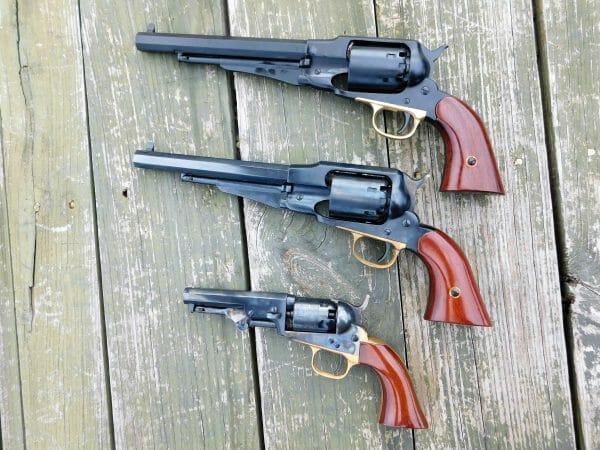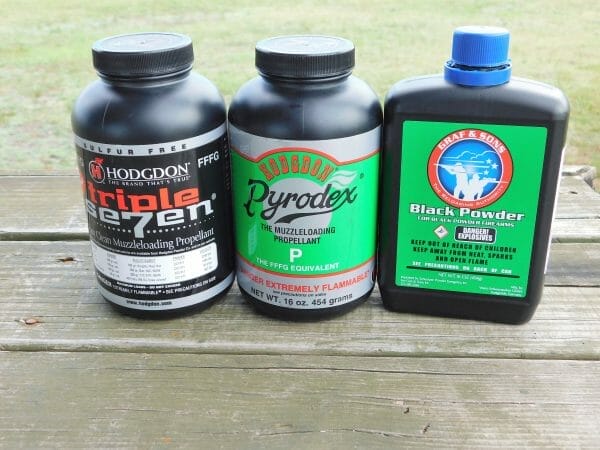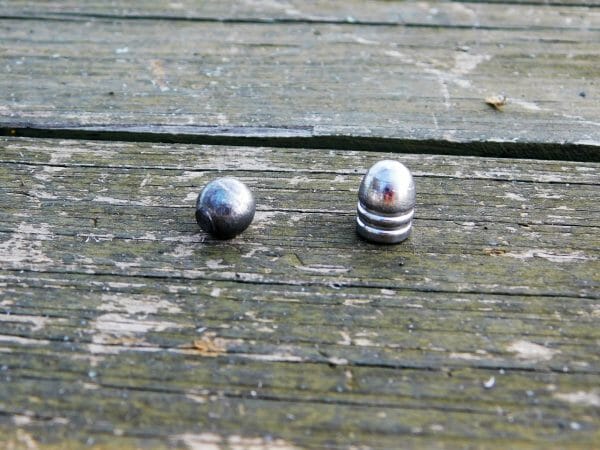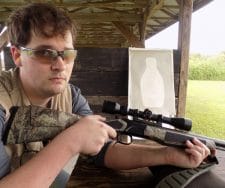
U.S.A. –-(Ammoland.com)- Percussion revolvers occupy a gray area in firearms development first appearing with the Colt Paterson in 1835 and in this awkward first step, reliable, repeating firearms suddenly became a reality after hundreds of years of frustrated design work. But only forty years later, percussion revolvers loaded with loose black powder, bullet, and percussion cap much like the muzzleloaders they replaces were themselves superseded by practical cartridge handguns. In that brief span of time, percussion aka cap and ball revolvers entered our imagination.
I haven’t been around nearly as long as many cap and ball enthusiasts but I can confidently say that I have over ten years of busting caps under my belt. In that time, I have found plenty to say and a fair number of myths to bust. I have sent plenty of lead into hillsides, water jugs, and game animals, but it is only recently that I began to wonder about the true power of the cap and ball revolver. It is a little-known fact that Colt’s 1847 Walker and 1848 Dragoon 44 caliber revolvers were the most powerful handguns issued by the United States military. But with the different calibers, bullets, and powders available, there has to be variation. I began to wonder how much. How fast are their bullets flying? How much power are those rounds really generating compared to modern cartridges? What is the difference between real black powder and the black powder substitutes on the market today? After all this time, I finally got around to wrangling a representation of all calibers, powders, and a chronograph all in one spot at the same time. So I went to work. But first, a bit of context.
What Is Black Powder and What the Heck is a Substitute?
The first guns that came on the scene were fueled by black powder–a careful mixture of charcoal, sulfur, and saltpeter. This remained the technology until the French invented modern smokeless powder in 1885. Until the turn of the twentieth century, most handguns–both muzzleloader, cap and ball, and cartridge–used black powder. Today, there are several firms that make black powder including Goex, Swiss, Grafs, Elephant, ect.
Black powder substitutes exist to solve some of the problems of black powder while still being safe to use in firearms designed for black powder. The main problem was the chore of cleaning. While this isn’t truly a chore to do, the substitute powders are touted as having less fouling than the real stuff and easier cleanup. These points are debatable and my experience, untrue. However, black powder, under federal law is still considered an explosive while the substitutes and smokeless powders are considered propellants. Hence, licensing and other fees to keep black powder on store shelves could be a hindrance to some big box stores. You are much more likely to find substitutes like Pyrodex, Triple 7, and Blackhorn 209 on the shelf at your local sporting goods store. This has created two camps of followers who debate what powder is best or if the powder they have available to them is any good.

Calibers
The caliber debate, like black powder itself, needs historical context. Though exact bore sizes have varied through the years, the calibers .31, .36., and .44 have existed since the dawn of the wheel gun and these are the three calibers you are most likely to encounter.
The 31 was developed as a civilian self-defense number with the 1848 Baby Dragoon and 1849 Colt Pocket revolvers. Later, Remington and others like Root and Manhattan Arms produced little five-shot pocket revolvers designed for up-close dirty work. These were the first legitimate repeating carry pistols and these sold the best in their time. The 31 was considered too light for military issue, but many found their way onto the battlefield as private purchase items. Today, Colt 1849 Pockets and Remington 1865 Pocket models round out this limited niche of a niche.
The 36, which is actually around .375 of an inch, has a more militaristic tradition. This boring was first introduced with Colt’s Paterson but was revived in the 1851 Navy. Other companies produced 36 caliber revolvers for Navy use. One long standing theory is that the Navy was less concerned with horses than the Army, so the 36 did perfectly fine for anti-personnel work. 36 caliber guns were extremely popular being a far step up from the little 31 caliber guns but guns chambered for the 36 tended to be lighter and easier to carry on the belt than the larger 44 caliber guns of the time. Ironically enough, during the American Civil War, the primary purchaser of “Naval caliber” pistols was the US Army. 36 caliber guns proved to be handy for Southerners too with old stocks of captured Navy pistols getting put to use and most southern produced guns were made in 36 caliber. Though there are many excellent 36 caliber pistols on the replica market today, the Colt 1851 Navy is easily the most famous and the most represented.
The 44 came to being as a result of Sam Colt’s attempts to get military contracts for his revolver design. The 36 had proven itself well in Texas, but the United States Army needed more punch than that to replace the array of large-bore single shot pistols that they were fielding. The 44, which uses a true 45 caliber bullet, had enough power to deal with man and horse when the monstrous 1847 Walker Colt made the scene in the Mexican War. Steel development allowed for a new generation of lighter, more manageable 44 caliber revolvers to come in the 1860s. Legendary Civil War sidearms like the Colt 1860 and Remington New Model Army come to mind.
In their time, the 31, 36, and 44 served their purposes well but what do the numbers say for the modern black powder shooter?

Test Parameters
I could be out all day testing the power of black powder handguns. Unfortunately, it would wear down my hands and take forever. So to make for a comprehensive test that would not go overly long, I selected archetypical test platforms, bullets, and powders.
I decided to kick the gel test and meat shoot down the road some more and settled on pure numbers given to me via my Caldwell Chronograph. The days I conducted my tests were overcast and humid at about eighty degrees Fahrenheit with the results taken ten feet from the muzzle.
The Not-So-Boring Charts
| 31 caliber .323 inch round ball Colt 1849 w/4 inch barrel | |||
|---|---|---|---|
| Charge (grains by vol.) | 10 | 15 | 20 |
| Graf’s FFFg | 478 | 583 | 750 |
| Triple 777 | 621 | 704 | 787 |
| Pyrodex P | 542 | 668 | 712 |
| 36 caliber .380 inch 84 grain round ball Remington NMN w/ 7 3/8 inch barrel | |||
|---|---|---|---|
| Charge | 20 | 25 | 30 |
| Graf’s FFFg | 678 | 876 | 905 |
| Triple 777 | 906 | 979 | 1081 |
| Pyrodex P | 896 | 951 | 1004 |
| 36 caliber .375 inch Lee 130 grain conical | ||
|---|---|---|
| Charge | 20 | 25 |
| Graf’s FFFg | 651 | 729 |
| Triple 777 | 741 | 822 |
| Pyrodex P | 691 | 801 |
| 44 caliber .457 inch 147 grain round ball Remington NMA w/ 8 inch barrel | ||||
|---|---|---|---|---|
| Charge | 20 | 25 | 30 | 40 |
| Graf’s FFFg | 609 | 671 | 797 | 873 |
| Triple 777 | 806 | 881 | 990 | 1077 |
| Pyrodex P | 710 | 788 | 973 | 1129 |
| 44 caliber .450 inch Lee 220 grain conical | ||||
|---|---|---|---|---|
| Charge | 20 | 25 | 30 | 40 |
| Graf’s FFFg | 582 | 658 | 781 | 901 |
| Triple 777 | 707 | 783 | 948 | 1099 |
| Pyrodex P | 642 | 718 | 892 | 1047 |
* * Velocity measured in feet per second. Results taken as an average of five-shot strings.
Summary
My testing certainly isn’t perfect but I hope it may be used as a template for those who are curious. Across caliber lines, the substitutes generate more velocity and therefore more power than standard black powder with Triple 777 being slightly more powerful on the whole than Pyrodex P when working with an equivalent volume weight. This allows you to use somewhat less substitute to get the same result as black powder. Using equivalent charges here was done for academic purposes and should not be attempted.
Having said that, the use of substitutes did little to help the little 31 caliber Colt. 50 grain balls were used because of the lack of conical bullet options and it was difficult to seat the ball over twenty grain of powder. Even with hopped-up charges, the 31 rivals the 25 ACP cartridge. Good enough for small game and pest control despite the small sights that come on these little pocket guns. 36-caliber guns boast larger chambers and bigger bullets with round ball loadings and light charges being more than acceptable for small game. Hotter round ball loads and conicals give the 36 the muzzle energy in the neighborhood of the modern 380 Auto, but the heavier bullet used by the 36 can produce more damage, giving it better capability on larger varmints. However, using conical bullets takes up more chamber room with less powder. The same is true with the 44, even with bigger chambers and bullets. Even so, the heaviest loadings across all projectiles and powders put the 44 into light 357 Magnum territory. This opens up the door for greater use of applications like close-end big game hunting–a niche quite a few people pursue with success on deer, hog, even bear.
In the end, I was left with empty canisters, dirty guns, and a newfound respect for black powder revolvers that I didn’t have before. Never before, have I seen all calibers compared and my thirst for this knowledge led me here. Are you going to be popping bunnies with a 31 or a foolish whitetail with a 44? Probably not. Like me, you will probably enjoy them for their historic significance and the sheer attention they get on the range.
Make no mistake, black powder revolvers have some power and it is nice, if not useful, to know just how much they bring to the table when called upon.
About Terril Hebert:
Terril Hebert is a firearm writer native to south Louisiana. Under his motto-Guns, Never Politics-he tackles firearm and reloading topics both in print and on his Mark3smle YouTube channel, where he got his start. Terril has a soft spot for ballistics testing, pocket pistols, and French rifles. When he is not burning ammo, he is indulging his unhealthy wildlife photography obsession or working on his latest novel. Scourge of God, published in 2017. See more from Terril on youtube under Mark3smle
